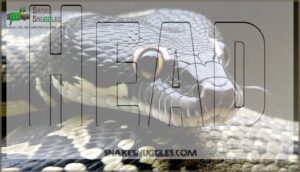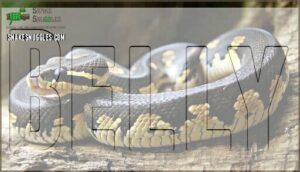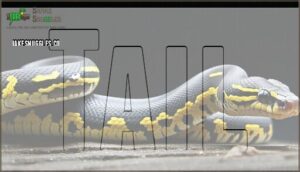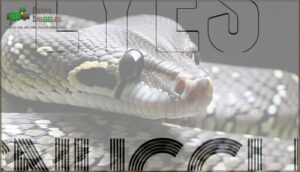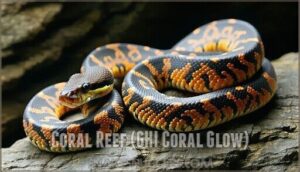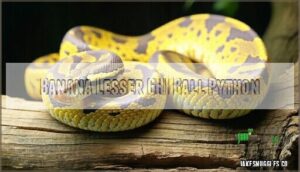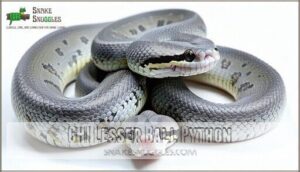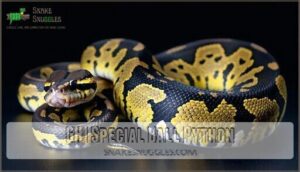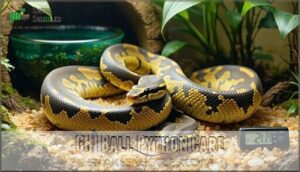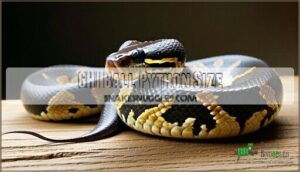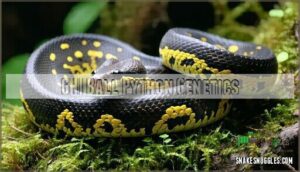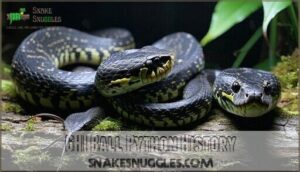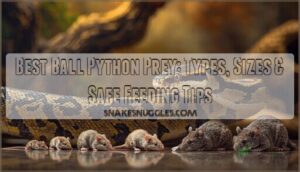This site is supported by our readers. We may earn a commission, at no cost to you, if you purchase through links.
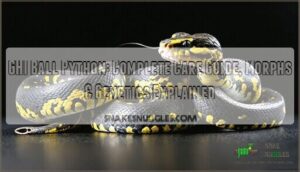
Discovered by Matt Lerer in 2007, this morph features an almost jet-black background with distinctive golden "alien head" markings and intricate puzzle-like patterns.
You’ll notice the extremely dark coloration creates dramatic contrast against those bright highlights throughout the body.
Since it’s co-dominant, you only need one GHI parent to produce GHI offspring, making breeding accessible for enthusiasts.
These snakes aren’t just about looks—their genetic potential opens doors to incredible combinations like Chernobyl and Coral Reef morphs that’ll leave you questioning everything you thought you knew about ball python genetics.
Table Of Contents
- Key Takeaways
- What is a GHI Ball Python?
- Physical Characteristics
- GHI Ball Python Morph
- GHI Ball Python Care
- GHI Ball Python Size
- GHI Ball Python Genetics
- GHI Ball Python History
- Frequently Asked Questions (FAQs)
- What is Ghi ball python?
- What is the rarest morph of ball python?
- What are the symptoms of the nidovirus in ball pythons?
- Why is my ball python on a hunger strike?
- What does ghi mean in a ball python?
- How big do Ghi ball pythons get?
- How to make a ghi ball python?
- What does the cinnamon gene do in ball pythons?
- What is a GHI ball python morph?
- What is a GHI ball python?
- Conclusion
Key Takeaways
- You’ll discover a stunning recessive morph featuring dark puzzle patterns and golden "alien heads" that creates one of the most visually striking ball pythons available.
- You can breed incredible designer combinations like Chernobyl and Coral Reef morphs since GHI’s genetics work well with other popular mutations.
- You’ll need both parents carrying the GHI gene to produce visual offspring, as this recessive trait requires specific breeding strategies for success.
- You can expect standard ball python care requirements with adults reaching 3-5 feet and thriving in proper temperature and humidity conditions.
What is a GHI Ball Python?
The GHI Ball Python is a striking color and pattern morph first discovered in 2007 by Matt Lerer in imported snake shipments from Africa.
You’ll recognize this unique python by its extremely dark "puzzle" pattern, golden "alien head" markings, and nearly black coloration that sets it apart from standard ball pythons.
**The GHI’s dark puzzle patterns and golden alien heads create an unmistakable masterpiece in the snake world.
Origin
The GHI Ball Python’s African lineage traces back to wild specimens imported from Africa, where these remarkable snakes developed their distinctive genetic traits.
You’ll find that Matt Lerer’s role proved pivotal when he discovered this Ball Python mutation in 2007 shipments.
Key origins include:
- African Lineage – Wild specimens from Africa carried the recessive trait
- Initial Import – Florida shipments contained the first known GHI specimens
- Genetic Source – Single exporter provided all three original discovery animals
This genetic discovery revolutionized snake genetics understanding, with early pricing reflecting the morph’s rarity and appeal among enthusiasts.
Discovery
Matt Lerer’s Discovery began when he unpacked imported ball python shipments in south Florida during 2007.
A single shipment from Africa changed ball python breeding forever.
Three snakes caught his attention despite being in deep shed – their genetic mutation was unmistakable.
Lerer’s Discovery proved this pattern mutation wasn’t random when identical Unique Traits appeared across separate shipments from one exporter, confirming Morph Confirmation of the GHI Ball Python.
| Discovery Aspect | Details | Significance |
|---|---|---|
| Import Origins | Single African exporter | Traced genetic source |
| Initial Recognition | Three identical snakes | Genetic discovery confirmed |
| Timeline | 2007 Florida shipments | ghi ball python established |
Characteristics
Your GHI ball python’s appearance stems from a fascinating pattern mutation that creates its signature look.
This color mutation transforms ordinary ball python snake morphology into something extraordinary.
You’ll notice the distinctive dark puzzle pattern covering the body, punctuated by striking golden alien heads that seem to glow against the black background.
Silvery flame sides add drama to the overall design.
Belly variations range from clear to heavily spotted, while the tail dorsal stripe features bright gold flanked by hollow alien head patterns.
Physical Characteristics
You’ll recognize a GHI ball python by its striking dark puzzle pattern and bright golden "alien heads" that make it stand out from regular ball pythons.
These snakes show dramatic color changes as they grow, starting nearly black as babies and developing more silver flames and blushing with age.
Head
You’ll immediately notice the GHI ball python’s head scalation features an almost entirely black head color that sets it apart from other morphs.
Head markings are exceptionally rare, creating a striking contrast with the body’s intricate puzzle pattern.
Dark eyes complement this dramatic appearance, though some individuals display lighter eye coloration.
This distinctive head creates the perfect backdrop for the signature alien heads pattern that flows throughout the body, making the black head color a notable feature.
Body
Your GHI ball python‘s body displays a mesmerizing dark "puzzle" pattern with golden "alien heads" that sets this morph apart.
The appearance showcases remarkable pattern variations and color intensity throughout the body:
- Dark puzzle-piece formations create intricate ball python patterns
- Golden "alien heads" with hollow, ring-like unique markings
- Silvery flames dance across the nearly black background
The scale texture and color patterns intensify as your snake matures, with growth patterns revealing more pronounced contrasts.
Belly
You’ll notice belly patterns on your GHI ball python range from completely clear bellies to heavily murky bellies with extensive spotting variations.
This belly diversity reflects complex belly genetics at work. Clear bellies typically indicate cleaner genetic expression, while murky bellies suggest multiple genetic interactions.
These appearance differences make each ball python morphs specimen unique, adding to the GHI ball python’s appeal among collectors who appreciate varied color patterns.
Tail
Moving from the belly’s variable spotting patterns, your GHI ball python’s tail showcases striking tail markings that mirror the body’s distinctive features.
The tail pattern displays hollow alien heads on each side of a bright-gold dorsal stripe.
This scale variation creates beautiful contrast against the dark background.
Ball python morphs like the GHI demonstrate how tail appearance perfectly complements the body’s overall design, making these snakes truly enchanting specimens.
Eyes
GHI ball python eyes typically appear dark, adding to their mysterious appeal. Most specimens display very dark eyes, though some surprise you with lighter variations. Eye color ranges from deep black to softer shades, while eye morphology remains consistent with standard ball python structure. Eye development follows normal patterns, with eye variations being subtle but noticeable among different individuals.
Regular eye health monitoring helps catch potential issues early. A cloudy appearance can signal impending shedding, a natural process. When identifying ball python morphs, eye characteristics provide helpful clues for snake morph identification.
- The windows to their soul reveal each GHI’s unique personality through subtle color differences
Understanding ghi ball python appearance includes recognizing how ball python genetics influence these distinctive features across various ball python morphs.
GHI Ball Python Morph
The GHI ball python stands out for its incredible pattern combinations that create truly unique morphs you won’t find anywhere else.
When you combine the GHI gene with other popular mutations, you’ll get some of the most sought-after designer ball pythons in the reptile world.
Chernobyl (GHI Cinnamon Paradox)
Everyone knows the Chernobyl morph represents ball python genetics at its most fascinating.
This rare GHI Ball Python combines intricate Pattern Intricacy with stunning Color Variations that defy expectations.
Dark chocolatey browns blend with bright, irregular patches through Paradox Genetics, creating unique ball python morphs.
Each specimen shows different markings due to the Rarity Factor – no two look identical.
The Breeding Potential remains unpredictable since paradox traits can’t be intentionally reproduced, making genuine Chernobyl discoveries incredibly valuable.
These snakes are considered genetic anomalies due to their mismatched colors and markings.
Coral Reef (GHI Coral Glow)
Beyond the Chernobyl combo, you’ll find another stunning designer ball python in the Coral Reef (GHI Coral Glow). This GHI Ball Python morph combines the dark puzzle patterns with vibrant coral-like oranges and yellows.
The Coral Reef genetics create spectacular color intensity variations that make each snake unique. What sets this morph apart:
- Enhanced blushing effects from GHI gene interaction
- Pattern uniqueness with coral-inspired coloration
Breeding challenges arise from combining recessive GHI with sex-linked Coral Glow traits. The snake morph market reflects high market value for these combinations, making Coral Reef specimens highly sought after among collectors.
These snakes can live for a surprisingly long time.
Banana Lesser GHI Ball Python
Creating a designer ball python like the Banana Lesser GHI requires serious breeding challenges and genetic expertise.
This triple-gene combination showcases stunning appearance variations with bright yellows, lavender hues, and reduced alien head patterns.
Ball python morph genetics get complex when combining three incomplete dominant traits, making these snakes rare finds.
Snake morph genetics influence pricing factors substantially – expect higher costs due to statistical breeding odds.
Genetic markers from each parent determine the final outcome, with sex ratios affected by Banana’s inheritance patterns.
Future morphs involving GHI ball python combinations continue expanding as breeders master multi-gene pairings.
GHI Lesser Ball Python
If you’re looking for something special, the GHI Lesser Ball Python delivers stunning results.
This morph combines two powerhouse genes to create something truly remarkable.
The Lesser gene impact transforms this snake’s appearance dramatically:
- Enhanced silver-gray coloration with metallic sheen
- Reduced pattern complexity with cleaner edges
- Intensified blushing around the head and neck
Color intensity reaches new heights when these genes interact.
Pattern variations show GHI’s signature "alien heads" softened by Lesser’s influence.
Breeding challenges arise from managing two genetic lines, but unique combinations reward patient breeders.
This ball python morph stands out among reptile morphs for its sophisticated appearance and growing popularity in the hobby.
GHI Special Ball Python
When you’re exploring GHI Special Ball Python morphs, you’ll discover a fascinating combination that merges two powerful genes.
This Special appearance showcases the GHI gene’s signature dark puzzle patterns alongside the Special gene’s distinctive flame-like belly markings. The Unique Markings create wacky pattern disruption that’s quite striking.
Your GHI Special displays metallic gold tones contrasting against near-black backgrounds. Breeding Potential remains strong for complex projects, though Rarity Factors keep prices elevated.
These ball python morphs represent excellent foundations for Future Morphs in selective breeding programs.
GHI Ball Python Care
Caring for your GHI Ball Python requires attention to three key areas that guarantee proper health and development.
You’ll need to provide appropriate feeding schedules, maintain suitable environmental conditions, and practice safe handling techniques to keep your snake thriving.
Diet
Your GHI ball python needs proper nutrition to thrive. These obligate carnivores require whole prey animals for complete nutrition. Prey size should match 1 to 1.5 times your snake’s midsection width, roughly 10% of body weight.
Feeding frequency varies by age: hatchlings eat every 5 days, while adults need meals every 2-4 weeks. Frozen-thawed prey is safer than live feeding since rodents can injure your snake. Thaw prey completely and warm to room temperature before offering.
Dietary supplements aren’t essential but occasional calcium dusting helps prevent deficiencies. Your GHI ball python will do well on mice or rats as primary rodents. Many keepers source their snake’s food from suppliers of feeder rodents.
- Rotate between different prey types like African soft-furred rats for nutritional variety
- Never microwave frozen prey – uneven heating can burn your snake’s mouth
Environment
Your GHI ball python needs a secure enclosure measuring 48" × 24" × 24" for adults.
Temperature gradients between 88-92°F on the warm side and 77-82°F on the cool side create comfort zones.
Humidity levels should stay at 50-60%, rising to 80% during shedding.
Ball pythons are native to Africa, so mimicking their natural environment is key.
Use under-tank heaters with thermostats—never overhead heat lamps, and opt for substrate options like aspen shavings or cypress mulch.
Enrichment needs include two snug-fitting hides and climbing branches for exercise, which are essential for the snake’s overall well-being and physical activity.
Handling
Proper ball python handling starts with patience and respect for your GHI ball python‘s temperament.
Use safe handling techniques by supporting their body fully and moving slowly. Handling frequency should be 1-2 times weekly, avoiding feeding days.
Watch for recognizing stress signs like balling up or hissing. For enhanced safety, consider using specialized handling equipment during interactions.
Supervise children handling closely. These exotic pet snakes respond well to gentle, confident ball python care approaches.
GHI Ball Python Size
GHI ball pythons reach adult sizes similar to standard ball pythons, typically measuring 3-5 feet in length when fully grown.
Adult females usually weigh between 3-5 pounds, while males stay slightly smaller at 2-3 pounds.
Average Length
Your ghi ball python will typically reach an adult size of 3-5 feet, though some individuals can stretch to 6 feet.
Gender differences play a role in ball python size – females usually grow larger than males.
Growth rate remains consistent with other ball python morphs.
Proper husbandry impacts growth, so verify their environment is well-maintained.
When planning your enclosure size, consider these measurement methods and expect steady growth over several years.
Weight
Adult GHI Ball Pythons typically weigh between 3-5 pounds, with females generally heavier than males.
Maintaining ideal weight requires monitoring your ball python’s growth rate and feeding schedule.
Overfeeding risks include obesity and shortened lifespan, while underweight signs include visible ribs and lethargy.
For breeding weight, females should reach 4-5 pounds before reproduction.
Regular weigh-ins help guarantee your GHI Ball Python maintains prime size and health throughout its life.
GHI Ball Python Genetics
Understanding GHI ball python genetics helps you make informed breeding decisions and predict offspring outcomes.
This morph follows specific inheritance patterns that determine which babies will display the striking GHI traits you’re looking for.
Recessive Trait
When you breed your ghi ball python, you’re working with a recessive trait that requires specific genetic testing strategies.
Unlike dominant genes, the GHI mutation stays hidden unless both parents carry it.
Breeding strategy considerations include:
- Visual identification proves impossible in heterozygous carriers
- Mutation origins trace back to wild African populations
- Future research may reveal the exact chromosomal location
Understanding inheritance patterns helps predict clutch outcomes.
Each breeding pair carrying the recessive gene produces roughly 25% visual GHI offspring.
This genetics principle explains why the morph remained undiscovered for so long in wild populations, making Matt Lerer’s 2007 discovery particularly significant for breeding programs.
Inheritance
Understanding recessive genetics in GHI ball pythons requires recognizing specific inheritance patterns. Both parents must carry recessive genes for offspring to display visual indicators.
The breeding outcomes follow predictable ratios: GHI x GHI produces 100% visual offspring, while het x het yields 25% visual, 50% het, 25% normal.
The super form appears completely black without health issues. Paradox occurrence remains extremely rare at less than 1%.
These recessive trait mechanics help predict your breeding success with ghi ball python projects.
GHI Ball Python History
The GHI ball python’s story begins in 2007 when Matt Lerer discovered three identical snakes with unusual dark patterns in imported shipments from Africa.
You’ll find it fascinating that he recognized their unique "alien head" patterns even while the snakes were in deep shed, leading to the first genetic proof of this now-popular morph.
Matt Lerer’s Discovery
Matt Lerer made history in 2007 when he discovered the GHI Ball Python while unpacking imported shipments in Florida.
He found two unusual babies in one box, then located a third matching snake days later from the same exporter.
This initial trio provided genetic proof of the new morph, with their distinctive puzzle pattern and golden alien heads setting them apart from normal ball pythons.
Initial Observations
Discovering these remarkable GHI Ball Python specimens revealed their Dark Coloration and Puzzle Pattern immediately.
Despite Shedding Impact obscuring details, their Unique Patterns and Golden Heads were unmistakable.
Matt’s Immediate Purchase decision proved wise—these snakes displayed distinct Alien Heads and silvery flames against black backgrounds.
Their Appearance featured hollowed markings and pin striping that established the ghi ball python as a groundbreaking morph discovery.
Many breeders create morphs through selective breeding methods, combining genes for unique traits.
Popularity
Since Matt Lerer’s groundbreaking discovery, the GHI Ball Python has become a phenomenon in reptile communities.
Here’s why this morph continues to captivate exotic pets enthusiasts:
- Morph Demand drives prices averaging $3,000 per snake, with rare combinations reaching $7,500
- Breeding Trends focus on creating striking multi-gene combinations that showcase GHI’s pattern-enhancing abilities
- Collector Appeal stems from the morph’s ranking among top ball python morphs for visual distinctiveness
- Price Factors reflect limited availability, with only three original specimens establishing this coveted lineage
Social Media platforms showcase thousands of GHI posts, while reptile enthusiasts anxiously await new combinations.
The morph’s codominant genetics enable diverse breeding projects, keeping breeders busy developing innovative pairings.
This sustained interest proves that sometimes the rarest discoveries become the most treasured additions to any collection.
Frequently Asked Questions (FAQs)
What is Ghi ball python?
Looking for a snake that’ll turn heads at every reptile show?
The GHI (Gotta Have It) ball python is a stunning morph discovered in 2007 by Matt Lerer, featuring dark puzzle patterns and golden "alien heads" that’ll make you fall in love instantly.
What is the rarest morph of ball python?
Rarity in ball pythons depends on genetics, discovery date, and breeding difficulty.
You’ll find morphs like Sunset, discovered in 2012, extremely rare due to recessive traits.
The sunset ball python morph is rare for several reasons.
First, the morph gene was just discovered in 2012, making availability limited.
What are the symptoms of the nidovirus in ball pythons?
This deadly virus is absolutely devastating your ball python’s respiratory system. You’ll notice mouth redness, excessive mucus production, and audible "clicking" sounds when your snake breathes, signaling serious respiratory inflammation.
Why is my ball python on a hunger strike?
Your ball python’s likely refusing food due to seasonal changes, stress from environmental factors, or natural feeding cycles. Check temperature, humidity, and minimize handling during shed periods.
What does ghi mean in a ball python?
GHI stands for "Gotta Have It" – a ball python morph discovered in
You’ll recognize it by its extremely dark puzzle-like patterns and distinctive golden "alien head" markings that create a striking, unique appearance.
How big do Ghi ball pythons get?
Like massive pythons that outgrow their first homes, GHI ball pythons reach the same impressive size as their wild cousins.
You’ll see your GHI grow to 3-5 feet long, with females typically stretching longer than males in adulthood, and this growth pattern is a key characteristic of these pythons.
How to make a ghi ball python?
Breeding requires two GHI parents since it’s a recessive trait.
You’ll need to pair GHI carriers or visuals together.
Expect roughly 25% GHI offspring when breeding two carriers, or 100% when pairing two visual GHI pythons together.
What does the cinnamon gene do in ball pythons?
Many people think cinnamon‘s just about looks, but you’re wrong. The cinnamon gene transforms your ball python’s brown pigment, creating rich caramel colors while reducing black patterns for stunning contrast.
What is a GHI ball python morph?
You’ll discover a striking ball python morph with an extremely dark "puzzle" pattern and golden "alien head" markings that make it instantly recognizable among collectors.
What is a GHI ball python?
GHI ball pythons showcase stunning genetics you’ll love.
They display dark "puzzle" patterns with golden "alien heads" across their bodies.
You’ll notice their nearly black background contrasts beautifully with bright yellow-gold markings and silvery flames along their sides.
Conclusion
Your journey with a GHI ball python opens doors to a world where genetics meets artistry.
These remarkable snakes combine stunning visual appeal with fascinating breeding potential, making them perfect for both beginners and experienced keepers.
With proper care, your GHI ball python will thrive for decades while potentially producing incredible offspring combinations.
The investment in understanding their genetics pays dividends through successful breeding projects and deeper appreciation for these magnificent creatures, allowing for a unique blend of artistry in the breeding process.
- https://www.worldofballpythons.com/morphs/ghi/
- https://www.morphmarket.com/us/c/reptiles/pythons/ball-pythons?q=banana+GHI+lesser
- https://budapestcafeorchestra.bandcamp.com/album/the-cinnamon-paradox
- https://vcahospitals.com/know-your-pet/snakes-diseases
- https://pangovet.com/pet-breeds/snakes/paradox-ball-python-morph/

